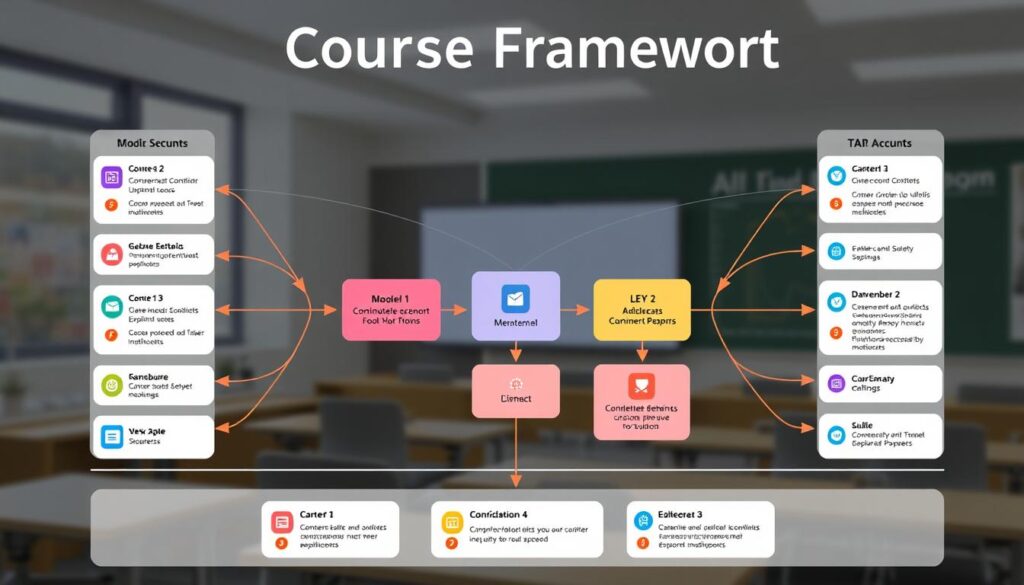Are you ready to dive into the booming e-learning market? The global e-learning market is expected to hit $375 billion by 20261. This shows a big jump in online learning. You can sell your courses online on sites like YouTube, TikTok, and Facebook. This makes it easier to find more students and boost your sales.
Wondering how to succeed in selling courses online? It’s all about making top-notch courses, creating engaging videos, and selling on the right platforms. These steps are key to a successful online learning site. With a solid plan, you can become a go-to expert in your field. This will draw in students eager to learn from you, helping your sales and earnings.
Key Takeaways
Table of Contents
- 1 Understanding the Online Course Marketplace in 2024
- 2 Essential Tools and Platforms for Selling Courses Online
- 3 Building Your Course Framework
- 4 Professional Course Production Techniques
- 5 The Best Platforms for Selling Courses Online
- 6 Marketing Your Course Across Social Media
- 7 Setting Up Your Automated Sales Funnel
- 8 Pricing Strategies and Payment Processing
- 9 Building Student Engagement and Community
- 10 Analytics and Performance Tracking
- 11 Conclusion: Launching Your Course Empire
- 12 FAQ
- 12.1 What is the current market size and potential of the online course marketplace?
- 12.2 What are some of the top-performing course categories in the online course marketplace?
- 12.3 What are the revenue opportunities in the e-learning industry?
- 12.4 What are the best tools and platforms for creating and selling online courses?
- 12.5 How can I choose the right course topic and structure the content effectively?
- 12.6 What professional course production techniques should I consider?
- 12.7 What are the best platforms for selling courses online?
- 12.8 How can I effectively market my courses across social media platforms?
- 12.9 How can I set up an automated sales funnel for my online courses?
- 12.10 How should I approach pricing strategies and payment processing for my online courses?
- 12.11 How can I build student engagement and community for my online courses?
- 12.12 What analytics and performance tracking tools should I use for my online courses?
- You can create and sell online courses on various platforms, including YouTube, TikTok, and Facebook, to increase your online course sales and reach a wider audience.
- The global e-learning market is projected to reach $375 billion by 2026, highlighting significant growth in online education1, making it an ideal time to start selling courses online.
- Building high-quality online courses, filming engaging content, and selling courses on platforms that cater to your target audience are essential for creating a successful e-learning platform and driving online course sales.
- With the right strategy, you can establish yourself as an expert in your niche and attract students who are eager to learn from you, ultimately increasing your online course sales and revenue.
- Selling online courses requires low upfront costs to get started, making it accessible for many entrepreneurs2, and can be a great way to create and sell online courses and increase your online course sales.
Understanding the Online Course Marketplace in 2024
The online course market is booming, with the global e-learning industry expected to hit $336.98 billion by 2026. It’s growing at a rate of 9.1% each year3. Course creators can make between $1,000 and $10,000 a month. Some even earn up to six figures in less than two years3. By 2029, the e-learning market is forecasted to reach $490 billion3.
Popular course subjects include computers, business, health, arts, education, writing, and more3. Online course platforms can take up to 50% of the revenue3. To thrive, it’s crucial to know the market size and top course categories.
Platforms like Udemy, Teachable, and Skillshare are great for selling courses. Udemy has over 73 million students and 75,000 instructors4. Skillshare offers over 35,000 premium courses for its members4. These sites have a built-in audience, while course creation software offers customization4.
To start, invest in a studio lighting kit and editing software like Wevideo. Costs are around $100 and $14 per month, respectively3. Recording multiple times can improve video quality. Experts recommend recording at least three times for the best results3. By understanding the market and creating quality courses, you can succeed in e-learning.
Essential Tools and Platforms for Selling Courses Online
To sell courses online, you need the right tools and platforms. Online course platforms like Kajabi and Teachable offer video hosting, marketing tools, and educational resources5. They provide a complete solution for creating and selling courses, letting you focus on making great content.
Course creation tools are key for making engaging courses. E-learning software like Thrive Apprentice and MemberPress have features for quizzes, drip content, and certifications6. These tools make learning smooth for students and can boost your earnings through memberships and downloads.
A digital course marketplace can also help you reach more people. These platforms let you sell your courses and often have a big customer base5. Using them can increase your earnings and grow your online course business.
Some popular online course platforms and their features are:
- Kajabi: video hosting, marketing tools, educational resources
- Teachable: course creation tools, payment processing, affiliate marketing
- Thrive Apprentice: quiz creation, drip content, certification options
- MemberPress: membership management, digital downloads, payment processing

Choosing the right tools and platforms is crucial for a successful online course business6. Think about your needs and goals when picking tools. Don’t hesitate to try different options until you find the best fit for you5.
Building Your Course Framework
Creating an online course starts with a solid framework. You need to pick a topic that your audience will love. Then, organize your content in a way that keeps learners interested. Studies show that 70% of instructors make money from their courses by following a clear plan7.
First, find a niche that you’re passionate about. Understand what your audience needs and what problems they face. This will help you create a course that really speaks to them.
A good course framework has a clear structure and engaging materials. This can include videos, quizzes, and interactive exercises. Research shows that video content boosts engagement by 90% compared to text8. Also, using visual outlines and timelines can improve retention by 25%9.
To build an effective course framework, remember these important points:
- Choose a topic that fits your expertise and interests your audience
- Plan your content with engaging materials and interactive exercises
- Use visual outlines and timelines to help learners remember more
By following these steps, you can make a successful online course. With the right topic, structure, and materials, you can keep learners interested. This will help you reach your goals as an online course creator.

Professional Course Production Techniques
Creating top-notch online courses requires professional techniques. This means using quality equipment like a good HD camera and lighting for better video recording10. Also, editing software like Wevideo or Final Cut Pro can make the final product more engaging for students11.
Using a green screen is also key for a professional look12. These methods help course creators make videos that are both informative and fun. Some top editing software includes:
- Wevideo
- Final Cut Pro
- Adobe Premiere Pro
By using these tools, course creators can improve their production quality. This leads to a more engaging learning experience for students10. Plus, high-quality production can boost student satisfaction and increase completion rates11.

| Equipment | Importance |
|---|---|
| Good HD camera | High |
| Lighting | High |
| Editing software | Medium |
| Green screen | Low |
The Best Platforms for Selling Courses Online
There are many ways to sell courses online. You can use platforms like Kajabi and Teachable, or marketplaces like Udemy and MasterClass. Learning management systems like WordPress and Moodle also offer great options. Each platform has its own benefits, from hosting and selling courses to reaching a large audience.
Kajabi, Teachable, and Thinkific are great for creating and selling courses. They come with tools for marketing and sales. Udemy and MasterClass, meanwhile, help you sell to a big audience and make money from your courses13. WordPress and Moodle let you customize and manage large courses14.
When picking a platform, think about the cost, features, and how easy it is to use. Teachable has different plans, including a free one, and supports over 150,000 creators15. Udemy takes a cut of your sales but has a huge audience14. The right platform can help you sell more courses and reach more people.

Other options include LearnWorlds, which lets creators make personalized apps for their courses14. With so many choices, you can find the best platform for selling your courses online today.
Marketing Your Course Across Social Media
Creating engaging content is key for social media marketing16. YouTube videos can boost your course’s exposure and sales16. TikTok can also help by sharing course snippets, leading to quick sales17.
Facebook marketing can expand your audience and promote your course well17. Using hashtags and paid ads can boost your efforts16. A solid social media strategy and promotional content can grow your online presence and sales17.
Here are some tips for marketing your course across social media:
- Share engaging content to attract potential students
- Utilize paid advertising options to reach a wider audience
- Leverage influencers to promote your course
- Create a sense of urgency with limited-time offers

| Platform | Marketing Strategy |
|---|---|
| YouTube | Create promotional videos and utilize paid advertising |
| TikTok | Share snippets of your course and leverage influencer marketing |
| Develop a Facebook marketing approach and utilize paid advertising options |
Follow these tips and use the right social media strategies to promote your course16. Always track your results and adjust your strategy for the best outcome17.
Setting Up Your Automated Sales Funnel
To succeed in course sales, you need a good sales funnel. This is a series of steps for potential customers, from first awareness to buying. There are four main stages: Awareness, Discovery, Consideration, and Conversion18. Knowing these stages helps you make a marketing automation plan to help leads and boost sales.
A well-made sales funnel automates your sales process, saving time and making things more efficient. Use email marketing tools and landing page builders for a smooth automated sales flow. Also, using social proof like testimonials can raise conversion rates by up to 34%18. These strategies help improve your sales funnel and increase course sales.
- Conversion rates drop as people move down the funnel18.
- Email marketing gives an average ROI of $42 for every $1 spent18.
- Retargeting campaigns can boost conversion rates by 10-30%18.
By knowing these stats and using them in yourmarketing automation plan, you can make a top-notchsales funnel. This will help drivecourse sales and grow your business.
Pricing Strategies and Payment Processing
When setting your course price, think about production costs, who you’re selling to, and what others are charging19. This helps you price your course right and attract buyers. Pricing strategies help you make more money, grow your market share, and add value to customers20. For example, famous universities use premium pricing to show they’re high quality21.
How you handle payments is key to a good customer experience. You can offer various payment plans, like one-time payments or subscriptions21. This makes it easier for more people to buy, boosting your sales. Also, offering refunds and guarantees can help build trust with your customers19.
There are many courses on pricing strategy, like those from IE Business School and University of Virginia19. These courses teach you how to create a pricing playbook. This is a tool to help you set the right prices for your products or services20. By learning about pricing strategies and payment options, you can make a successful online course that keeps customers coming back.
Building Student Engagement and Community
As a course creator, you know how key student engagement and community building are. They help your online courses succeed. By creating a community and encouraging course discussion, you boost student participation and better course results22. It’s also vital to offer feedback and support to keep students motivated and involved.
To do this, you can try several methods, such as:
- Setting up a special discussion forum for students to talk with each other and the course material
- Hosting regular live sessions or Q&A sessions for feedback and support
- Encouraging students to share their progress and achievements with the community
These strategies help build a supportive and engaging community. This community is key for students to reach their learning goals. As studies show, feeling part of a community, being accountable, and feeling like they belong are crucial for student engagement in online courses22. Also, offering content in various formats, like videos, audio, and discussion boards, caters to different learning styles. This can lead to better retention and satisfaction among students23.
By focusing on community building and student engagement, you can make a positive learning space. As you work on your course, keep your students’ needs in mind. Always check and improve your ways of handling course discussion, feedback, and support22.
| Strategy | Benefits |
|---|---|
| Creating a dedicated discussion forum | Increases student participation and engagement |
| Offering regular live sessions or Q&A sessions | Provides feedback and support to students |
| Encouraging students to share their progress and achievements | Fosters a sense of community and accountability |
Analytics and Performance Tracking
To sell courses online well, you must track important metrics and use data to improve your course. This means using analytics tools to watch how students engage, how many finish the course, and how much money it makes24. By looking at these numbers, you can find what needs work and make smart choices to better your course.
Important metrics include how many students finish, how engaged they are, and how much money it makes. Tools like Google Analytics can help track these and give you insights into how your course is doing25. Many course platforms also have analytics tools to help you track and improve your course.
By using data to make your course better, you can make your content more engaging, get more students, and make more money. For instance, you can see which topics students like most and change your course to fit that26. Keeping an eye on and tweaking your course can make it more effective and successful.
Popular tools for course analytics include Google Analytics, analytics from course platforms, and third-party tools. These tools give you detailed info on how your course is doing and help you make smart choices to improve it. By using these tools and tracking key metrics, you can make your course better and more effective.
Conclusion: Launching Your Course Empire
Building a successful online course business needs careful planning and ongoing improvement27. By following the steps in this guide, you can set up a strong course launch. This will help you build a thriving course sales business27.
For a successful course launch, focus on good course marketing and engaging your audience27. Use pre-launch campaigns to create excitement. Then, use email marketing and social media to boost sales during the cart open phase27. Always check your analytics to make your strategy better27.
With the right tools and strategies, your online course business can grow into a huge empire. It can offer life-changing education to students all over the world28.
So, what are you waiting for? Begin planning your course and connect with your audience. Let your course empire start to grow. The online learning world offers many chances. With hard work and determination, you can reach your goals and make a big difference28.
FAQ
What is the current market size and potential of the online course marketplace?
The online course market is growing fast. By 2024, it’s expected to reach new heights. This offers course creators a great chance to make money.
What are some of the top-performing course categories in the online course marketplace?
Top categories include computers, business, and health. These areas are always in demand. They give course creators a chance to become experts.
What are the revenue opportunities in the e-learning industry?
Course creators can make money through sales, affiliate marketing, and sponsored content. These options help increase earnings and build a strong online course business.
What are the best tools and platforms for creating and selling online courses?
Many tools and platforms are available for creating courses. Each has its own benefits. It’s key to choose the right one for your business.
How can I choose the right course topic and structure the content effectively?
Picking the right topic and structuring content well are crucial. Identify a niche and understand your audience. Create a detailed course outline that engages and values your students.
What professional course production techniques should I consider?
Use video recording, editing, and green screens for professional production. Good equipment and editing software like Wevideo or Final Cut Pro are essential for quality content.
What are the best platforms for selling courses online?
Standalone options like Kajabi and Teachable are great. So are marketplace platforms like Udemy and MasterClass. Each has its own benefits and drawbacks. Choose the best for your business.
Create engaging content and use hashtags on platforms like YouTube, TikTok, and Facebook. A good social media strategy can help you reach more people and sell more courses.
How can I set up an automated sales funnel for my online courses?
An automated sales funnel is key for easy sales and more revenue. Create lead magnets, tripwires, and core offers. Use tools like email marketing software and landing page builders for a smooth journey.
How should I approach pricing strategies and payment processing for my online courses?
Consider production costs, audience, and competition when pricing. Offer payment plans and manage refunds. Use secure payment gateways like Stripe and PayPal for a smooth payment experience.
How can I build student engagement and community for my online courses?
Engage students through discussions, feedback, and support. Use tools like forums and social media groups to build a community. This fosters a positive learning environment and boosts completion rates.
What analytics and performance tracking tools should I use for my online courses?
Track metrics like completion rates, engagement, and revenue. Tools like Google Analytics and course platform analytics offer insights. They help you improve your courses and business.



